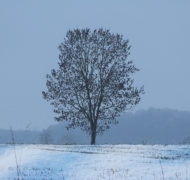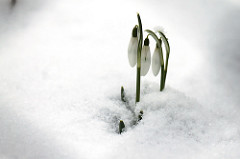All Things New: In the Winter of Despair
Blog / Produced by The High Calling
Each year I think I’ll enjoy winter—I imagine building snowmen, watching little kids lick icicles, having snowball fights, and wrestling with my kids in the tall snow.
But with each fun winter activity comes the cold, the deadness of the plants, the dreary skies. By about mid-January, I’ve had enough of winter, and I just want it to end.
The Winter of Our Daily Lives
Tim Keller opens his book Walking with God through Pain and Suffering by saying, “Suffering is everywhere, unavoidable, and its scope often overwhelms.” There is no getting around it.
I know this first-hand, as I’m sure you do. I have friends who are experiencing a greater amount of suffering than I am at this time, as I’m sure you have as well. It all feels so dry, cold, and bleak.
I recently had a conversation with a friend who has been going through a tremendously hard time, and all I could hear in her voice was hopelessness. I told her, as unequivocally as I could, “Do not lose hope.” She had two choices in that dark moment: to despair or to find hope. There were no other options. Anne Lamott wrote, “Hope begins in the dark, the stubborn hope that if you just show up and try to do the right thing, the dawn will come. You wait and watch and work: you don’t give up.”
Finding Hope in the Springtime of Re-Creation

We can’t deal with the winter without the hope of springtime.
Just when the winter has taken its toll on me, I look out my front window into one of my wife’s flower gardens, the one next to our front porch. And there they are! The first little white flowers of spring show up—popping out through a layer of snow—the snowdrops!
Out of the dead ground, there is new creation! When all seemed hopeless, tiny little blooms are standing their ground against the cold and harsh environment, as if to say, “Oh yea, winter? Look at little me! By God’s grace, I will live! Do you hear me? I will live!”
Perennials like snowdrops must experience the cold winter temperatures in order to flower. Yes, winter has its purpose.
Gerald Sittser observes that in Keller’s book, he “is especially critical of the modern and secular view of suffering, which … assumes that God, if he exists at all, exists solely to make us happy. This view helps explain why so many people avoid suffering at all costs, do their best to manage and minimize it once it interrupts their lives, and often yield to utter hopelessness when it persists.”
The Christian faith takes suffering seriously—at its center is the One who suffered and who is with us in our suffering. And it is also a faith that offers real hope.
The hope of Christianity is in rebirth. It is in renewal, in redemption, in reconciliation, in restoration. It is in resurrection.
Notice all the re- words there? Christianity is a faith of the re-. And re- is the prefix of hope. God is currently doing something with what we are, who we are, and where we are. God is making the new creation.
“If anyone is in Christ, the new creation has come: The old has gone, the new is here!” (2 Cor. 5:17). The 1984 version of the NIV had this verse saying, “If anyone is in Christ, he is a new creation.” But the “he” is not there in the original Greek. The newer translation corrects this, making it clearer that when anyone is in Christ, then the snowdrops of this grand new creation are there to see! It is an indication that God is making all things new! Charles Self observes that “new creation” indicates that a person in Christ is a “microcosm of the new heavens and new earth.”
All Things New
Having the hope that God is making all things new changes everything. What if God is already springing up flowers of hope in this cold, dark world?
What if our present lives in Christ are meant to be indicators of the fullness of what’s to come? What if the resurrection of Jesus is truly the “firstfruits” for the redemption of “all things” (as Sky Jethani insists in his book, Futureville)?
What if this hope fuels us to "vow to love people in their messiness, pain, and turmoil, and fight shoulder to shoulder with them for the long haul" (as Beth A. Strand has been experiencing)?
What if the hope of the future actually informs how our work matters in the here and now (as J. Richard Middleton discovered)?
Without the hope of the assured springtime—of budding flowers, singing birds, chirping crickets, of blue skies and green grass and leaves again on the trees—we surely cannot get through the winter of our daily lives.
Amber Haines reminds us that "Jesus is the author and perfecter of our faith (Heb. 12:2) and waiting becomes an active engagement with hope at its core."
The good news is that the springtime has already begun in the death and resurrection of Jesus Christ. We find hope in the realization that God makes all things new.
Do we have eyes to see the snowdrops?
Snowdrops image by elPadawan. Used with Permission. Source via Flickr.




